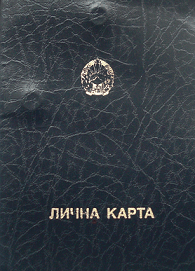Macedonian identity card
The Macedonian identity card (Macedonian: Лична карта) is a compulsory identity document issued in North Macedonia. The document is issued by the police on behalf of the Ministry of Interior.
| Macedonian identity card (Лична карта) | |
|---|---|
 Macedonian identity card | |
| Type | Identity card, optional replacement for passport in the listed countries |
| Issued by | |
| Valid in | |
| Eligibility | 16 years of age |
Physical appearance
The Macedonian identity card is plastic ID-1-(bankcard) format. The left side shows a photograph of the face the bearer. On the top left corner of the front, the name Република Северна Македонија (Macedonian)/Republic of North Macedonia (English) in capitals, and below it the word Личната карта/Identity card is shown. The flag and the coat of arms are also displayed on the identity card. Every person over 18 is required to obtain an identity card.
Printed data

The descriptions of the fields are printed in Macedonian and English.
- Front side:
- Surname
- Name
- Nationality
- Sex
- Date of birth
- Personal number
- Date of issue
- Date of expiry
- Holder's signature
- Back side:
- Place of birth
- Permanent residence
- Address
- Authority
- ID number
- Machine-readable zone starting with IDMKD
International travel
The Macedonian ID card can be used for travelling to and staying in some countries without the need for a passport on the basis of bilateral agreements:[1]
History
In the late 19th-early 20th century, when the area of modern-day North Macedonia was still part of the Ottoman Empire, the residents of the region, like other Ottoman citizens, were required to hold Ottoman identity cards. The cards were known in Ottoman Turkish as nüfus tezkeresi.,[6] or in Bulgarian as nofuz (Bulgarian: нофуз).[7] Contemporary local ethnographer Krste Misirkov demanded that the ethnicity of Macedonian Slavs be identified on these cards as "Macedonian".[8]
See also
- North Macedonian passport
- Driving licence in North Macedonia
Notes
| a. | ^ Kosovo is the subject of a territorial dispute between the Republic of Kosovo and the Republic of Serbia. The Republic of Kosovo unilaterally declared independence on 17 February 2008, but Serbia continues to claim it as part of its own sovereign territory. The two governments began to normalise relations in 2013, as part of the 2013 Brussels Agreement. Kosovo is currently recognized as an independent state by 97 out of the 193 United Nations member states. In total, 112 UN member states recognized Kosovo at some point, of which 15 later withdrew their recognition. |
References
- In Montenegro only with ID cards Archived 2012-03-23 at the Wayback Machine
- "Archived copy" (PDF). Archived from the original (PDF) on 2016-03-27. Retrieved 2015-10-21.CS1 maint: archived copy as title (link)
- "Archived copy". Archived from the original on 2015-12-22. Retrieved 2015-10-21.CS1 maint: archived copy as title (link)
- Chris Gratien, Ottoman Identity Card; includes images of the cards
- Kunchov, Vasil (1900), Makedonii͡a (in Bulgarian), Sofia: Bulgarskoto Knizhevno Druzhestvo, p. 135
- Misirkov, Krste (1903), Za Makedonskite Raboti (On Macedonian Affairs) (in Macedonian), Sofia, p. 38
External links
- Ministry of Internal Affairs - Republic of North Macedonia (in Macedonian)